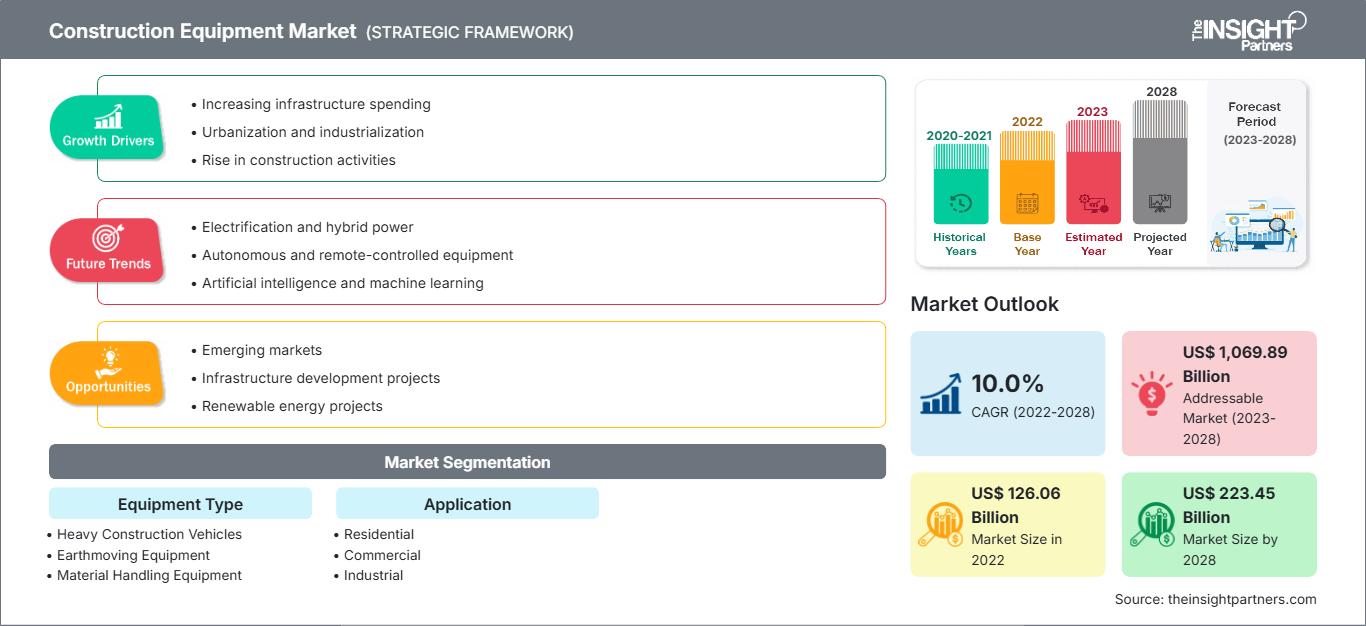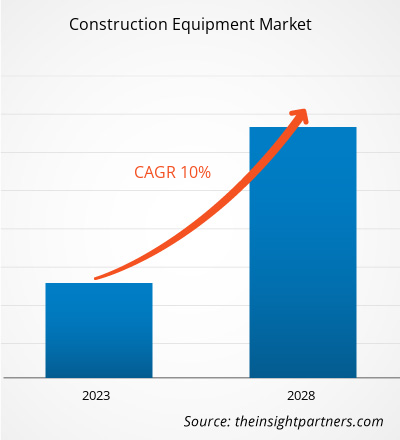Si prevede che il mercato delle attrezzature per l'edilizia crescerà da 126.062,8 milioni di dollari nel 2022 a 223.451,1 milioni di dollari entro il 2028; si stima una crescita a un CAGR del 10,0% dal 2022 al 2028.
I veicoli pesanti sviluppati specificamente per svolgere lavori di costruzione, più comunemente operazioni di movimento terra, sono definiti attrezzature per l'edilizia. L'uso corretto di attrezzature idonee contribuisce all'economicità, alla qualità, alla sicurezza, alla velocità e alla tempestività del progetto. Non è sempre auspicabile o fattibile che l'appaltatore possieda tutte le attrezzature necessarie per il progetto. Scavare, estrarre terra, spostarla su grandi distanze, posizionarla, compattarla, livellarla, spianarla, livellarla e trasportarla sono tra i principali processi coinvolti nella realizzazione di qualsiasi progetto edilizio. Varie attività di scavo, come lo scavo e lo spostamento del terreno, vengono eseguite con macchine movimento terra. Le macchine movimento terra sono disponibili in varie forme e dimensioni. Sono utilizzate principalmente per lavori di riparazione, costruzione, sollevamento, agricoltura e demolizione. Gli escavatori sono macchine movimento terra dotate di benne, bracci, cabine rotanti e cingoli mobili. Un escavatore a terna, noto anche come retroescavatore o escavatore posteriore, è un tipo di attrezzatura da scavo dotata di una benna da scavo fissata all'estremità di un braccio articolato in due parti. La pala caricatrice è una macchina edile che sposta o carica materiali, tra cui asfalto, rifiuti di demolizione, terra, neve, mangimi, ghiaia, tronchi, minerali grezzi, materiale riciclato, roccia, sabbia e trucioli di legno, dentro o sopra un altro tipo di macchinario.
Potrai personalizzare gratuitamente qualsiasi rapporto, comprese parti di questo rapporto, o analisi a livello di paese, pacchetto dati Excel, oltre a usufruire di grandi offerte e sconti per start-up e università
Mercato delle attrezzature per l'edilizia: Approfondimenti strategici

-
Ottieni le principali tendenze chiave del mercato di questo rapporto.Questo campione GRATUITO includerà l'analisi dei dati, che vanno dalle tendenze di mercato alle stime e alle previsioni.
I principali attori del mercato delle attrezzature per l'edilizia sono le materie prime, i produttori di attrezzature per l'edilizia che operano sul lato dell'offerta e gli utilizzatori finali di attrezzature per l'edilizia che operano sul lato della domanda. Negli ultimi anni, la domanda di attrezzature per l'edilizia, soprattutto nell'edilizia residenziale e commerciale, è aumentata, il che dovrebbe trainare la crescita del mercato delle attrezzature per l'edilizia nei prossimi cinque anni. Caterpillar, John Deere, Komatsu, Volvo e Liebherr sono tra i principali fornitori di attrezzature per l'edilizia. Oltre a questi importanti attori dell'ecosistema, vi sono diversi altri attori periferici che svolgono un ruolo cruciale nel consentire i progressi tecnologici e l'adozione di questi prodotti in diversi settori.
Impatto della pandemia di COVID-19 sul mercato delle attrezzature per l'edilizia
Nel 2020, la pandemia di COVID-19 ha ostacolato le attività di costruzione. Di conseguenza, le vendite di attrezzature per l'edilizia sono diminuite in tutto il mondo. Gli investimenti infrastrutturali, l'edilizia residenziale, commerciale e industriale, la costruzione di pozzi sotterranei e la spesa istituzionale incidono sui produttori di attrezzature per l'edilizia. Stati Uniti, Regno Unito, Cina e India sono tra i Paesi colpiti in modo sproporzionato. Secondo l'International Construction Group, la consegna di oltre un quarto di tutti i progetti (22,7%) è stata ritardata di oltre 250 giorni e più di un decimo di tutti i progetti (13,4%) è stato ritardato di oltre un anno nel 2020. Tuttavia, i progetti di ospedali e altre strutture mediche, laboratori e infrastrutture di spedizione e logistica sono in offerta limitata. Inoltre, diverse nazioni hanno iniziato a riprendere gradualmente le attività in vari settori, tra cui l'edilizia. India e Cina hanno avviato progetti di edilizia industriale e commerciale. Nell'aprile 2021, la produzione industriale è aumentata per la prima volta da gennaio 2021, con l'inizio dell'implementazione di nuovi progetti da parte dei Paesi. Pertanto, la domanda di escavatori, terne, compattatori, bulldozer e altre macchine edili è aumentata.
Approfondimenti di mercato: aumento degli investimenti infrastrutturali dopo la pandemia di COVID-19
Le attività economiche in tutto il mondo sono state notevolmente soffocate dalla pandemia di COVID-19. Nel 2020-21 sono stati effettuati ingenti investimenti in infrastrutture, che hanno dato impulso alla crescita del settore. Gli investimenti infrastrutturali nella produzione di energia elettrica, nella costruzione di autostrade nazionali, nelle ferrovie e nel trasporto merci hanno spinto la domanda di macchine edili. Nelle economie emergenti, alcuni settori infrastrutturali chiave, tra cui carbone, petrolio greggio, acciaio e cemento, hanno registrato un indice di crescita nel 2021. Questi fattori hanno avuto un impatto positivo sulla crescita del mercato delle macchine edili. Gli investimenti infrastrutturali hanno un impatto a lungo termine sullo sviluppo dei prodotti, che può aumentare il PIL nel lungo periodo, sebbene l'entità di questi effetti sia sconosciuta. La maggior parte dei paesi, in particolare in Medio Oriente, ha istituito un forum economico quadrilaterale per concentrarsi sui progetti di sviluppo infrastrutturale nella regione. Per facilitare la comunicazione tra dipendenti e consumatori, le aziende utilizzano soluzioni e canali digitali. Anche governi e istituti scolastici hanno fatto lo stesso.
Approfondimenti sui segmenti di mercato per tipologia di attrezzature
Un numero sempre maggiore di attrezzature edili viene utilizzato, a causa del crescente numero di progetti commerciali, residenziali e industriali che richiedono utensili e macchinari pesanti per portare a termine il lavoro. Nei progetti di grandi dimensioni, le attrezzature edili pesanti vengono impiegate per vari compiti. La scelta del tipo di attrezzatura pesante si basa sulla portata e sul costo del progetto. Questi fattori facilitano e accelerano il processo di costruzione. Gli escavatori sono un'attrezzatura essenziale e di frequente utilizzo nel settore edile.
Approfondimenti sui segmenti di mercato per applicazione
In base all'applicazione, il mercato delle attrezzature edili è segmentato in residenziale, commerciale e industriale. Un attrezzo da costruzione noto come impianto di miscelazione dell'asfalto viene utilizzato per produrre pietrisco rivestito e altri tipi di conglomerato bituminoso da utilizzare nei progetti di costruzione stradale. I rulli compressori sono essenzialmente macchine edili simili a compattatori che spingono terra, ghiaia, calcestruzzo o asfalto durante la costruzione di strade e fondamenta. Per l'installazione di pali prefabbricati per grattacieli e altri enormi complessi industriali che necessitano di fondamenta profonde, viene utilizzata una perforatrice per pali per creare fori verticali in un cantiere, con conseguente crescita del mercato delle attrezzature per l'edilizia. Gli operatori del mercato delle attrezzature per l'edilizia si concentrano su innovazioni e sviluppi di nuovi prodotti integrando tecnologie e funzionalità avanzate per competere con la concorrenza. Nel giugno 2022, Caterpillar Inc. ha annunciato che la sua sede centrale mondiale sarà trasferita da Deerfield, Illinois, all'attuale stabilimento aziendale di Irving, Texas. L'azienda inizierà il trasferimento della sua sede centrale a Irving nel 2022. In base al tipo di attrezzatura, il mercato delle attrezzature per l'edilizia è segmentato in veicoli per l'edilizia pesante, macchine movimento terra, attrezzature per la movimentazione dei materiali e altri. Il mercato, in base all'applicazione, è segmentato in residenziale, commerciale e industriale. In base alla regione, il mercato globale delle attrezzature per l'edilizia è segmentato in Nord America, Europa, Asia-Pacifico, Medio Oriente e Africa. Africa e Sud America.
Mercato delle attrezzature per l'ediliziaLe tendenze regionali e i fattori che influenzano il mercato delle attrezzature per l'edilizia durante il periodo di previsione sono stati ampiamente spiegati dagli analisti di The Insight Partners. Questa sezione analizza anche i segmenti e la geografia del mercato delle attrezzature per l'edilizia in Nord America, Europa, Asia-Pacifico, Medio Oriente e Africa, America Meridionale e Centrale.
Ambito del rapporto sul mercato delle attrezzature per l'edilizia
| Attributo del rapporto | Dettagli |
|---|---|
| Dimensioni del mercato in 2022 | US$ 126.06 Billion |
| Dimensioni del mercato per 2028 | US$ 223.45 Billion |
| CAGR globale (2022 - 2028) | 10.0% |
| Dati storici | 2020-2021 |
| Periodo di previsione | 2023-2028 |
| Segmenti coperti |
By Tipo di attrezzatura
|
| Regioni e paesi coperti |
Nord America
|
| Leader di mercato e profili aziendali chiave |
|
Densità degli operatori del mercato delle attrezzature per l'edilizia: comprendere il suo impatto sulle dinamiche aziendali
Il mercato delle attrezzature per l'edilizia è in rapida crescita, trainato dalla crescente domanda degli utenti finali, dovuta a fattori quali l'evoluzione delle preferenze dei consumatori, i progressi tecnologici e una maggiore consapevolezza dei vantaggi dei prodotti. Con l'aumento della domanda, le aziende stanno ampliando la propria offerta, innovando per soddisfare le esigenze dei consumatori e sfruttando le tendenze emergenti, alimentando ulteriormente la crescita del mercato.

- Ottieni il Mercato delle attrezzature per l'edilizia Panoramica dei principali attori chiave
Mercato delle attrezzature per l'edilizia - Profili aziendali
- Caterpillar Inc.
- CNH Industrial NV
- Hitachi Construction Machinery Co., Ltd
- JC Bamford Excavators Ltd.
- Deere & Company
- Komatsu Ltd.
- Liebherr-International Deutschland GmbH
- Terex Corporation
- Volvo CE
- Zoomlion Heavy Industry Science and Technology Co., Ltd.
- Analisi storica (2 anni), anno base, previsione (7 anni) con CAGR
- Analisi PEST e SWOT
- Valore/volume delle dimensioni del mercato - Globale, Regionale, Nazionale
- Industria e panorama competitivo
- Set di dati Excel
Report recenti
Testimonianze
Motivo dell'acquisto
- Processo decisionale informato
- Comprensione delle dinamiche di mercato
- Analisi competitiva
- Analisi dei clienti
- Previsioni di mercato
- Mitigazione del rischio
- Pianificazione strategica
- Giustificazione degli investimenti
- Identificazione dei mercati emergenti
- Miglioramento delle strategie di marketing
- Aumento dell'efficienza operativa
- Allineamento alle tendenze normative






















 Ottieni un campione gratuito per - Mercato delle attrezzature per l'edilizia
Ottieni un campione gratuito per - Mercato delle attrezzature per l'edilizia